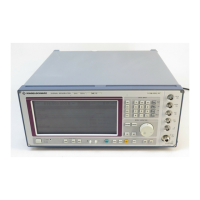Test Procedure SME
1038.6002.02 5.18 E-13
À Screw the bridge or the directional coupler onto the SME again.
À A more or less wavy line representing the VSWR of the SME is to
be seen now at the spectrum analyzer. The VSWR is to be
calculated from the maximal and the minimal voltage according to
VSWR = v
max
/v
min
VSWR with test levels
≤
0 dBm, f
≤
3 GHz ......................... max. 1.5
VSWR with test levels
≤
0 dBm, f
> 3 GHz ......................... max. 2.0
VSWR with test levels > 0 dBm........................................... max. 2.0
VSWR with test levels > 0 dBm, f > 5 GHz, with SM-B9 .... max. 2.5
Passive measurement of the
VSWR with output levels of the
SME below -30 dBm
À Settings at the second signal generator
- Test frequency
- Level 10 dBm.
À Screw off VSWR bridge or directional coupler from the test object
and note down the level measured at the analyzer as a reference
value.
À Screw on the bridge or directional coupler again and determine the
new level at the analyzer.
À The output reflection coefficient r of the test object is the voltage
ratio test level/reference level. It serves to determine the voltage
standing wave ratio (VSWR) according to the formula
VSWR=(1+r)/(1-r)
5.2.13 Interrupt-free Level Setting (ATTEN FIXED)
Test equipment Power meter (Section 5.1, item 8)
Test setup Connect the power meter to the RF output of the SME.
Measurement À Settings at the SME
- 1000 MHz, unmodulated,
- Level 8.0 dBm,
- Select FIXED in the LEVEL/LEVEL ATTEN menu.
À Note down the level read at the power meter as a reference level or
set the power meter to 0 dB for relative measurement.
À Now reduce the level in steps of 5 dB at the SME.
The following deviations should not be exceeded:
Attenuation Tolerance
-5 dB ±0.2 dB
-10 dB ±0.4 dB
-15 dB ±0.6 dB
-20 dB ±0.8 dB

